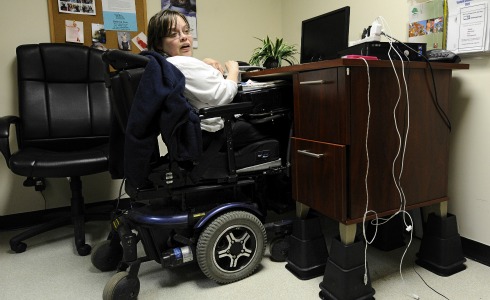 Pictured, Jennifer Lortie works in her Willimantic, Conn., office. Of the 29 million working–age Americans with a disability Lortie, who has limited arm and leg use due to cerebral palsy, is one of the 5.1 million who are actually employed. The National Council on Disability’s Jeff Rosen says long-standing prejudicial attitudes need to be addressed to boost jobs. (AP Photo/Jessica Hill)
Pictured, Jennifer Lortie works in her Willimantic, Conn., office. Of the 29 million working–age Americans with a disability Lortie, who has limited arm and leg use due to cerebral palsy, is one of the 5.1 million who are actually employed. The National Council on Disability’s Jeff Rosen says long-standing prejudicial attitudes need to be addressed to boost jobs. (AP Photo/Jessica Hill)
WASHINGTON — Whether it means opening school track meets to deaf children or developing a new lunch menu with safe alternatives for students with food allergies, recent Obama administration decisions could significantly affect Americans with disabilities. But there’s been little progress in one of the most stubborn challenges: employing the disabled.
According to government labor data, of the 29 million working-age Americans with a disability — those who are 16 years and older — 5.2 million are employed. That’s 18 percent of the disabled population and is down from 20 percent four years ago. The employment rate for people without a disability was 63 percent in February.
The job numbers for the disabled haven’t budged much since the passage of the Americans with Disabilities Act of 1990, which gave millions of disabled people civil rights protections and guaranteed equal opportunity in employment, public accommodations, transportation, government services and more.
The National Council on Disability’s Jeff Rosen said longstanding prejudicial attitudes need to be addressed to boost jobs.
“Employers are still catching on to the fact that the needs of most workers with disabilities aren’t special, but employees with disabilities often bring specialized skills to the workplace,” Rosen said. “Perhaps no one knows how to adapt, think critically or find solutions better than someone who has to do so daily in order to navigate a world that wasn’t built with them in mind.”
Rosen, who is deaf, was named in January as chairman of the council, an independent federal agency that advises the president, Congress and other federal agencies on disability policy.
The Obama administration recently has acted to expand the rights of Americans with disabilities in other areas.
The Education Department’s civil rights division released new guidelines that direct schools to provide students with disabilities equal access to extracurricular sports teams. If schools can’t, they should create similar athletic programs for disabled children, the department said.
Also, the Justice Department said in a settlement with a Massachusetts college, Lesley University, that severe food allergies can be considered a disability under the law. That potentially could lead to new menus and accommodations at schools, restaurants and other places to address the needs of people with food allergies.
One silver lining in the lagging employment for the disabled has been federal hiring.
The latest data from the U.S. Office of Personnel Management shows nearly 15 percent of new federal hires between 2010 and 2011 were people with disabilities — almost 19,000 people. That’s up from the previous year when about 10 percent of new hires were people with disabilities.
President Barack Obama signed an executive order in 2010 aimed at improving the federal ranks of people with disabilities. The goal was to add 100,000 disabled people to federal payrolls in five years; that would be within reach if the 2010-2011 hiring numbers were to stick or improve.

